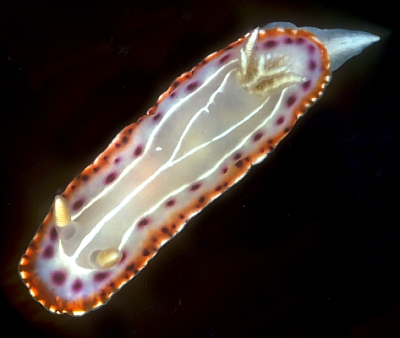
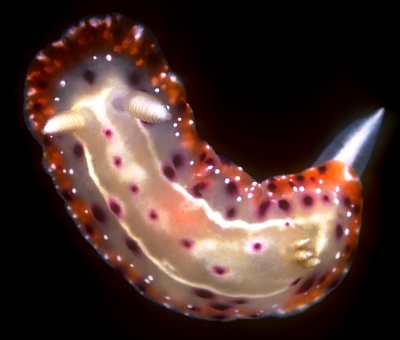
Chromodoris decora
(Pease, 1860)
Order: NUDIBRANCHIA
Suborder: DORIDINA
Family: Chromodorididae
DISTRIBUTION
Tropical and subtropical Pacific and Indian Oceans.
PHOTO
Upper: Colour form with white Y-shaped pattern on back. Iluka, northern New South Wales, Australia. March 1982. 2 mm long alive, AM C132942. Lower: Colour form with purple spots in centre of back. Noumea, New Caledonia, October 1988. Grows to approximately 20 mm long. AM C 156627. Photos: Bill Rudman.
The background colour of the mantle is a translucent straw colour. There is considerable colour variation but the most distinctive feature is an opaque white line running down the dorsal midline which bifurcates to form an inverted Y.
At the mantle edge there can be a thin opaque white line whic is often broken into a series of white spots or patches. Inside this is a broad translucent orange band which obscures the dendritic opaque white mantle glands. There is a thin opaque white line which runs around the mantle, parallel to the edge, just encircling the rhinophore and gill pockets. Between this intense white line and the orange border the mantle is dusted with white or bluish white but not so intensely as the thin line. Outside the thin white line the mantle skirt is scattered with reddish purple or purple spots of varying sizes.
From between the rhinophores a thin white line runs down the dorsal midline to midway where it bifurcates to form a loop around the gill pocket. The rhinophores are a translucent straw colour with an opaque white core and the simple gills are similarly coloured, the lamellae being a creamy-brown straw colour with the interior of each gill opaque white.
There is some variation in colour pattern and sometimes the purple spots on the orange border are few or absent. Also, the region between the orange band and the white line encircling the gills and rhinophores varies from being as unpigmented as the central region to almost as heavily pigmented as the white line. In other specimens the Y-shaped white line and the encircling white line can be scattered with purple spots, and in others the Y-shaped line can be broken or have extra branches.
However, in all specimens studied the basic colour pattern can be found with an orange border, a white ring running around the mantle just outside the gills and rhinophores, a white median line bifurcating midway down the body to form a loop around the gill pocket, and a row of large diffuse purple spots between the orange border and the thin white outer ring.
The mantle is elongately ovate with a wide mantle overlap. The simple gills are arranged in a circle, open posteriorly, around the anus. Large dendritic mantle glands form a submarginal band all around the edge of the mantle beneath the orange margin.
Colour variations are discussed more fully in a separate message [#20717 ]
• See Chromodoris cf. decora
• See Chromodoris decora Colour Group
-
Pease, W.H. (1860). Descriptions of new species of mollusca from the Sandwich Islands. Proceedings of the Zoological Society of London, 28: 18-37.
-
Rudman, W.B. (1984) The Chromodorididae (Opisthobranchia: Mollusca) of the Indo-West Pacific: a review of the genera. Zoological Journal of the Linnean Society 81: 115-273.
-
Rudman, W. B. (1986) The Chromodorididae (Opisthobranchia: Mollusca) of the Indo-West Pacific: Noumea purpurea and Chromodoris decora colour groups. Zoological Journal of the Linnean Society 86(4): 309-353.
Rudman, W.B., 2007 (September 13) Chromodoris decora (Pease, 1860). [In] Sea Slug Forum. Australian Museum, Sydney. Available from http://www.seaslugforum.net/find/chrdec
Related messages
Chromodoris lekker or C. decora from Sri Lanka
September 22, 2007
From: Anouk Houben
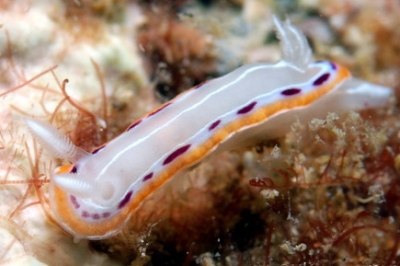
Found these 2 Chromodoris decora on the reefs off Negombo on the West-Coast of Sri Lanka. Although the coloration is identical, the median line shows multiple branches in the first one, and a smooth line in the second. In both animals the median line does not bifurcate, but runs up to the gills, which it encircles.
Locality: Second reef, Negombo, 14m, Western Province, Sri Lanka, Indian Ocean, 5 April 2007, Silty reef. Length: 3cm. Photographer: Anouk Houben.
Anouk Houben
nashiman@lankacom.net
Houben, A., 2007 (Sep 22) Chromodoris lekker or C. decora from Sri Lanka. [Message in] Sea Slug Forum. Australian Museum, Sydney. Available from http://www.seaslugforum.net/find/20757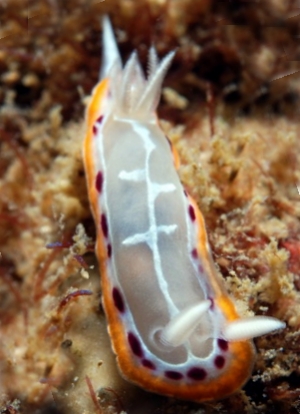
Dear Anouk,
This is a very interesting find. It has links to the common South Pacific form of Chromodoris decora with a plain white median line that forks posteriorly, and with the 'Chromodoris ndukuei' form with multiple branching off the median white line [see message #20717]. You mention the white line encircling the gills in your animal. The South Pacific form does this as well but the line is not so close to the gill pocket. My first thought when I saw your photos was how close this looks to the South African Chromodoris lekker. If you look at photos from Reunion Island [#18783] there is a clear link between the white blotches on the mantle and the white lines in your animal. In fact in the lower left photo the blotched have aggregated to form parts of the median line, the outer lines and the lateral branches.
Apart from the obvious colour similarities both C. lekker and C. decora are linked by the white pigment on the rhinophores, the white line up each translucent gill and the white median line on the posterior tip of the foot. I will also need to check Kelaart's early descriptions of species from Ceylon [Sri Lanka] to see if perhaps it already has a name.
Best wishes,
Bill Rudman
Identity of Chromodoris decora
September 14, 2007
From: Bill Rudman
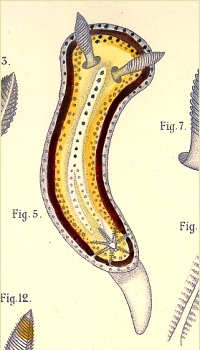

Upper: Chromodoris decora [from Bergh, 1880: Plate B, fig 5]. Lower left: Chromodoris lentiginosa [from Pease, 1871: Plate 9, fig 1]. Lower right: Chromodoris ndukuei [from Risbec, 1928: Plate VI, fig 2].
Scott Johnson's recent messages [#20696, #20697] on the identity of Chromodoris decora have caused me to actually prepare a description for the Fact Sheet - which until now included only photos - and to post these scans of illustrations from early descriptions of this species and some other species which I consider synonyms.
Pease's description of Doris decora did not include an illustration but as I discuss in Scott Johnson's message with photos of Hawaiian specimens [#20697], his upper photo matches Pease's written description almost exactly:
"Dorsal region pale straw-colour, with a medial whitish longitudinal stripe, which is bifurcated posteriorly and dotted with purple. The margin of the mantle is bordered with white and dotted with purple; an intramarginal light red band, contiguous with a yellow one, which is dotted with purple ...."
I have included a scan of Bergh's (1880) illustration of Chromodoris decora as I am pretty sure it was seen by Pease. Both Pease and Bergh used material collected and painted by Andrew Garrett. As I have discussed elsewhere this dual arrangement sometimes led to confusion with both Pease in Hawaii and Bergh in Europe describing the same species [same specimens? illustrations?] with different names [see #1852 ]. In this case however Bergh has acknowledged Pease's name for the species.
Pease (1871) later described Chromodoris lentiginosa from Tahiti, which appears to be a specimen of the C. decora in which the bifurcating white line is not entire. He describes the 'median interrupted cream coloured stripe in which are disposed purple spots.... '.
Another name is Chromodoris ndukuei Risbec, 1928, which surely represents an animal in which the white Y shaped median line has multiple branches. It looks very like the upper photo in Scottt Johnson's feeding photo in message #20701.
The other name, which I haven't illustrated is Chromodoris setoensis Baba, 1938 which is the colour form in which the Y-shape white line lacks purple spots. Baba himself (1953) suggested it should be considered a synonym of C. decora. I may be wrong, but all these forms seem to represent variations of one species. The most distinctive features of the pattern are the white line that encircles the gills and rhinophores and the the median line which bifurcates.
- Baba, K. (1938) Opisthobranchia of Kii, Middle Japan. Journal of the Department of Agriculture. Kyusyu Imperial University, 6(1): 1-19.
- Baba, K. (1953) Three new species and two new records of the genus Glossodoris from Japan. Publications of the Seto Marine Biological Laboratory 3(2): 205-211.
-
Bergh, L.S.R. (1880): Malacologische Untersuchungen. In: C.G. Semper, Reisen im Archipel der Philippinen, Wissenschaftliche Resultate. Band 2, Suppl. 1, 1-78, Pls.A-F.
-
Pease, W.H. (1860). Descriptions of new species of mollusca from the Sandwich Islands. Proceedings of the Zoological Society of London, 28: 18-37.
-
Pease, W.H. (1871) Descriptions of new species of Nudibranchiate Mollusca inhabiting Polynesia. No.2. American Journal of Conchology. 7 (1): 11-19
-
Risbec, J. (1928) Contribution a l'étude des nudibranches Néo-Calédoniens. Faune des Colonies Francaises 2(1): 328, pls.1-12.
- Rudman, W.B. (1984) The Chromodorididae (Opisthobranchia: Mollusca) of the Indo-West Pacific: a review of the genera. Zoological Journal of the Linnean Society 81: 115-273.
-
Rudman, W. B. (1986) The Chromodorididae (Opisthobranchia: Mollusca) of the Indo-West Pacific: Noumea purpurea and Chromodoris decora colour groups. Zoological Journal of the Linnean Society 86(4): 309-353.Baba, K. (1938) Opisthobranchia of Kii, Middle Japan. <i>Journal of the Department of Agriculture. Kyusyu Imperial University, 6(1)</i>: 1-19.
Bill Rudman
Rudman, W.B., 2007 (Sep 14) Identity of Chromodoris decora. [Message in] Sea Slug Forum. Australian Museum, Sydney. Available from http://www.seaslugforum.net/find/20717Hawaiian Chromodoris decora
September 14, 2007
From: Scott Johnson
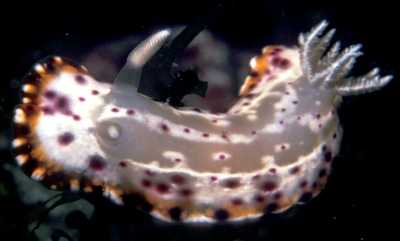
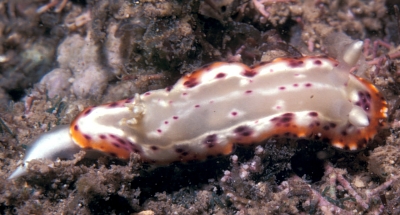
Hi Bill,
These three photos show Chromodoris decora from the Hawaiian Islands, from where the species was originally described by Pease. At least in the late 1970s they were relatively common along the wall of the channel leading into the Ala Wai Yacht Harbor in Honolulu, where they seemed to primarily feed on a jet black sponge. A specimen eating a small patch of the sponge is shown in the lower photo. Hawaiian specimens resemble one of the two distinct forms from the Marshalls in that they have purple spots within the white middorsal markings. However, they lack the scattered discrete white spots seen in Marshall Islands specimens of that form, instead having larger white patches along the very edge of the margin.
Locality: Oahu, 5m, Hawaii, USA, Pacific, 1979, Exposed on channel walls. Length: 15-20 mm. Photographer: Scott Johnson.
Scott Johnson
uwkwaj@yahoo.com
Johnson, S., 2007 (Sep 14) Hawaiian Chromodoris decora. [Message in] Sea Slug Forum. Australian Museum, Sydney. Available from http://www.seaslugforum.net/find/20697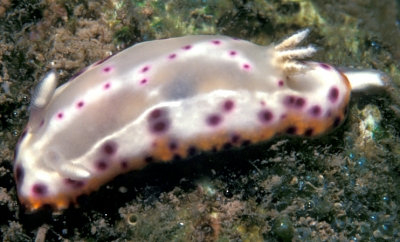
Dear Scott,
Thanks for all these photo showing colour variation and feeding in C. decora. Your upper photo is almost a perfect match for Pease's written description.
'Dorsal region pale straw-colour, with a medial whitish longitudinal stripe, which is bifurcated posteriorly and dotted with purple. The margin of the mantle is bordered with white and dotted with purple; an intramarginal light red band, contiguous with a yellow one, which is dotted with purple ....' Pease, 1860, p.29.
-
Pease, W.H. (1860). Descriptions of new species of mollusca from the Sandwich Islands. Proceedings of the Zoological Society of London, 28: 18-37.
Best wishes,
Bill Rudman
Marshall Islands Chromodoris decora
September 14, 2007
From: Scott Johnson
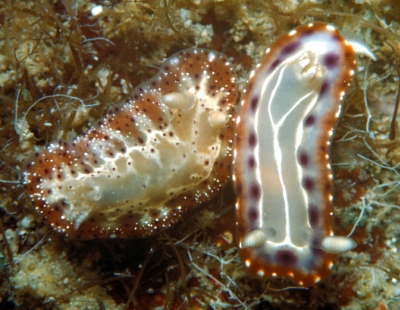
Hi Bill,
This is a follow up on my note questioning Chromodoris decora [#20695 ]. I have observed a large number of these animals both here in the Marshalls and in the type locality of Hawaii and I think there are two species here. The photos here were taken of animals that were not found together like this - these two pairs of specimens were each put together to illustrate the similarities and differences. The similarities are obvious. Both have wide orange margins that contain white spots. There are purple spots mostly submarginally, and the dorsum is sort of a milky or yellowish gray with white markings. Gills and rhinophores are very similar in shape. Also, the egg masses of both contain similar extra-capsular yolk.
The differences are also pretty apparent from the photos. One form (call it form 1) has white patches (glands?) mostly restricted to a single line near the edge of the orange margin, while the other (form 2) has discrete white spots scattered throughout the orange margin. Form 1 has a very regular white line bordering the central part of the dorsum and a distinct white line running down the center that bifurcates and surrounds the gills, while in form 2 the white lines are often broken, the central one often has multiple branches, and the central white lines and branches are spotted with purple. The purple spots in form 1 are in two rows, a row of usually large spots just outside the white dorsal oval line and a row of small spots within the orange margin. In form 2, the purple spots tend to be more uniform in size and scattered in less regular rows.
True, these could all be just variations - both forms are variable, but here in the Marshalls at least they do not seem to overlap. And although it is not something I can demonstrate in pictures, one of the most telling differences is that many of the 133 specimens of these two forms I have recorded here in the Marshalls have been paired or sometimes even in groups of 3. None of those were in mixed groups. They always paired up with the same form, even though they both could be found on the same reefs under similar conditions.
Unfortunately, what might be the biggest problem with separating these two forms into different species is that specimens from the type locality do not exactly match either of them, although they seem closer to form 2. I'll send some photos of Hawaiian specimens separately. Form 1 looks like the drawing of the species given the name "setoensis " by Baba in 1938.
Locality: Enewetak Atoll, 4-5 m, Marshall Islands, Pacific, 1983, Under rocks on lagoon reef. Length: 15-20 mm. Photographer: Scott Johnson.
Scott Johnson
uwkwaj@yahoo.com
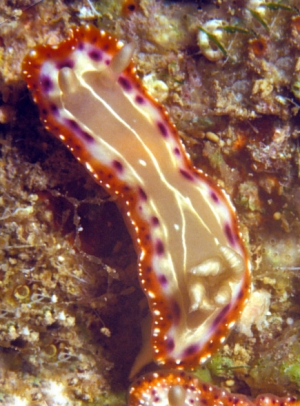
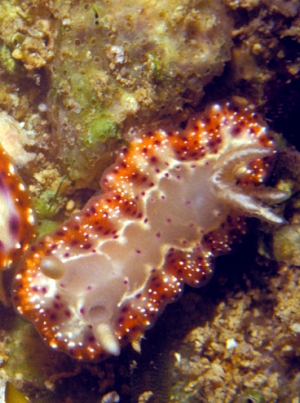
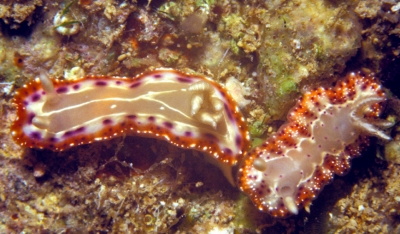
Dear Scott,
Your observations about 'look-alikes' pairing up may be signficant, and I could of course be quite wrong, so if anyone wants an indepth project on a single? species this could be an interesting project.
Best wishes,
Bill Rudman
Feeding in Chromodoris decora [3]
September 13, 2007
From: Scott Johnson
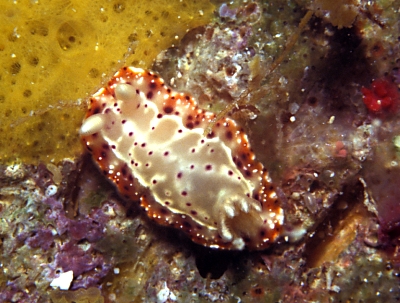
Hi Bill,
Here are some additional feeding records for one of the Chromodoris decora forms. These three photos show specimens from Enewetak Atoll feeding on three different sponges. The species also feeds on a jet black sponge in both Hawaii and the Marshalls. I will send a separate message of those [#20700 ].
Locality: Enewetak Atoll, 4-5 m, Marshall Islands , Pacific, 1983, Under rocks on lagoon reef. Length: 15-20mm. Photographer: Scott Johnson.
Scott Johnson
uwkwaj@yahoo.com
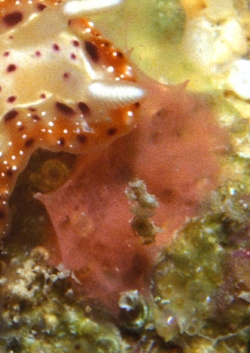
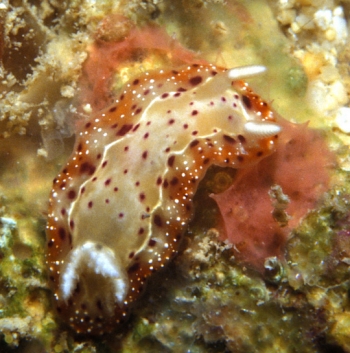
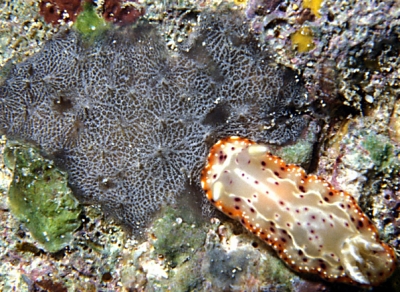
Dear Scott,
As I mentioned in your earlier messages [#20700, #20695] there is a remarkable similarity between the food eaten by this species and that reported by you earlier for Chromodoris fidelis from the same places.
In your upper photo I am pretty sure the animal is not eating the yellow sponge at the top of the photo, but is just finishing the last of a dark purplish colony which used to live where it is sitting. I obviously can't be sure and can't identify the space but I wouldn't be surprised if it is the remains of Chelonaplysilla violacea. By coincidence you have a photo of C. fidelis [#12220] with the same yellow sponge abutting a colony of C. violacea.
The lower photo is an unnamed species of Chelonaplysilla which Pat Bergquist also identified as a food of C. fidelis from another of your messages [#12229].
The middle photo shows an animal eating a sponge, very similar to that reported by Denis Riek [#20634] - the message which prompted your response. I'll have to get Pat Bergquist to check its identity.
Best wishes,
Bill Rudman
Feeding in Chromodoris decora [2]
September 13, 2007
From: Scott Johnson
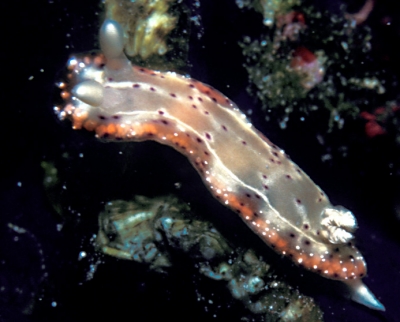
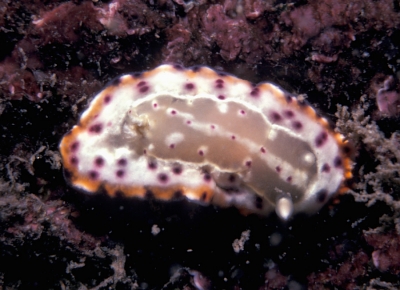
Hi Bill,
These three shots show Chromodoris decora in both Hawaii and the Marshalls on a jet black prey sponge.
Locality: various, 4-10m, Pacific, various. Length: 10-15mm. Upper photo: Kwajalein, Marshall Islands [e327-k12]; Middle photo: from Oahu, Hawaii [h129-o05]; Lower photo: Enewetak, Marshall Islands [e327-e06]. Photographer: Scott Johnson.
Scott Johnson
uwkwaj@yahoo.com
Johnson, S., 2007 (Sep 13) Feeding in Chromodoris decora [2]. [Message in] Sea Slug Forum. Australian Museum, Sydney. Available from http://www.seaslugforum.net/find/20700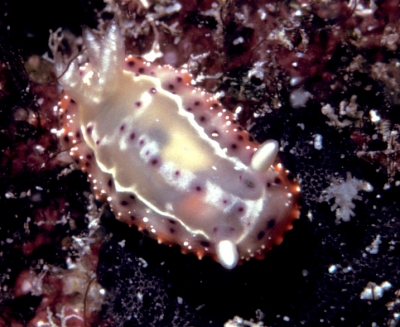
Dear Scott,
This is interesting. Jet black sponges are not that common, but Pat Bergquist (1996) in a discussion on Chelonaplysilla mentions that there are least two unnamed species including a 'purple-black' one, known only from a single specimen from Hawaii, which she has examined. I will of course need to check with her, but since in your other messages most of the sponges eaten by C. decora seem to be species of Chelonaplysilla, I wouldn't be at all surprised if the records in this message are of that undescribed species of Chelonaplysilla.
Interestingly, an earlier message of yours [#12230] reports C. fidelis feeding on this sponge as well.
-
Bergquist, P.R. (1996) The marine Fauna of New Zealand: Porifera: Demospongiae Part 5. Dendroceratidae and Halisarcida. New Zealand Oceanographic Institute Memoir, 107: 1-53.
Best wishes,
Bill Rudman
Feeding in Chromodoris decora [1]
September 13, 2007
From: Scott Johnson
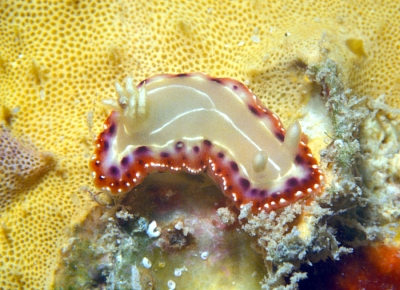
Hi Bill,
As a follow up to Denis Riek's message [#20634] regarding feeding in Chromodoris decora, here are a few more records from the Marshall Islands. The animals figured were certainly feeding on the yellow and gray sponges; I am not as certain that the third was actually feeding on the purple Chelonaplysilla violacea, although it looked pretty suspicious since the area just above the animal appears to have been grazed.
However, I am not convinced that these are Chromodoris decora, although I have to admit the situation to me is not clear. I will follow up on that comment in subsequent messages [#20696, #20697 ].
Locality: Enewetak Atoll, 4-5 m, Marshall Islands, Pacific, 1982 - 1883, Under rocks on lagoon reef. Length: 15-25 mm. Photographer: Scott Johnson.
Scott Johnson.
uwkwaj@yahoo.com
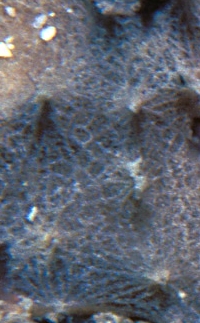
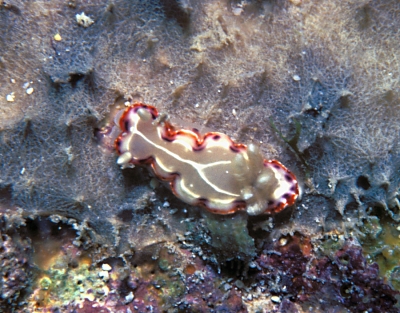
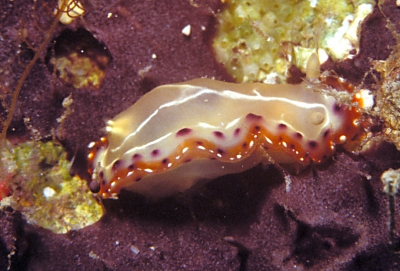
Dear Scott,
This message, and your other two [#20700, #20701], give us a pretty comprehensive idea of the food choice of at least this 'colour form' of C. decora. As I also discuss in those messages, this species shows a remarkable similarity in diet to Chromodoris fidelis, eating all the sponges you recorded for that species, which were all species of Chelonaplysilla.
The upper photo shows the same unnamed yellow species as shown in messages #12232, #12231, #12221, the middle photo shows another unnamed species in message #12229, and the sponge in the bottom photo is Chelonaplysilla violacea, also eaten by C. fidelis [#12220].
Best wishes,
Bill Rudman
Chromodoris decora feeding?
September 4, 2007
From: Denis Riek
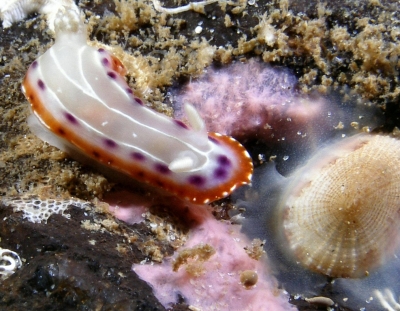
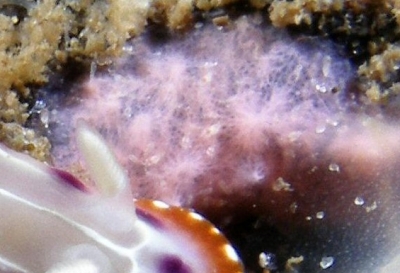
Dear Bill,
These two Chromodoris decora were found in the Brunswick River recently. One was under a rock on a pink sponge and the other in the open. Both animals were stationary on the sponges but, being only a snorkeller I cannot confirm they were actually feeding. I have found waiting around to make observations can lead to complications (drowning!)
Locality: Brunswick River, 4-5 metres, northern New South Wales, Australia, Pacific, 17 July 2007, Rock wall in river, high tide. Length: 16 mm. Photographer: Denis Riek.
Cheers
Denis
dwriek@optusnet.com.au
Riek, D.W., 2007 (Sep 4) Chromodoris decora feeding?. [Message in] Sea Slug Forum. Australian Museum, Sydney. Available from http://www.seaslugforum.net/find/20634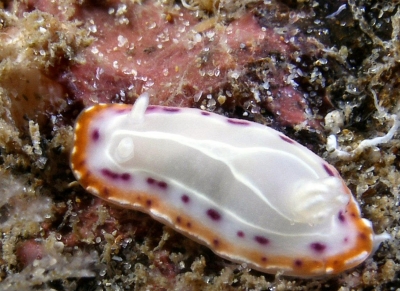
Dear Denis,
Thanks for this interesting observation. It is the first hint of a food sponge for C. decora, but as you say, we will need to get some further observations before we can be sure. I think we can accept your desire to stay alive as a reasonable excuse for not sticking around to see if the Chromodoris would eat the sponge. In the upper photo, and close-up, there seems to be good signs of the sponge being eaten but unfortunately the limpet-like fissurellid snail at the right of your photo could have been the culprit. Unfortunately we know even less about the diet of many marine snails than we do about nudibranchs, but many fissurellids are found closely associated with sponges, so there is a real possibility that in this case the fissurellid was the culprit.
But I think we keep a look out for C. decora and a pink sponge.
Best wishes,
Bill Rudman
Chromodoris decora from the Red Sea
February 24, 2005
From: Oren Lederman
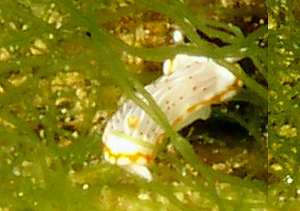
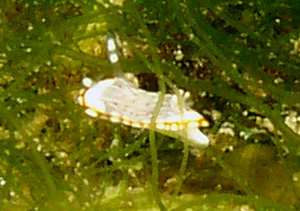
Hi Bill,
Is this Chromodoris decora?
Locality: Near the "Yetush" ( mosquito) shipwreck, Eilat Bay, Israel, Red Sea, Depth: ~22 meters. Length: ~1 cm. 18 Feb 2005. Photographer: Oren Lederman.
Oren Lederman.
lederman@bigmail.co.il
Lederman, O., 2005 (Feb 24) Chromodoris decora from the Red Sea. [Message in] Sea Slug Forum. Australian Museum, Sydney. Available from http://www.seaslugforum.net/find/13213Dear Oren,
I think this is a form of Chromodoris decora which has been reported before from the Red Sea. It has small reddish spots on the mantle and fine longitudinal white lines. There are a couple of species from southern Africa which look somewhat similar Hypselodoris carnea and Hypselodoris capensis, but both of those have a blue or purplish mantle border. Have a look at the Chromodoris decora Colour group page to see some of the similarly coloured species. There is always the possibility that it is something else. We would need to examine its anatomy to be sure.
Best wishes,
Bill Rudman
Chromodoris decora from Christmas I., E. Kiribati
June 27, 2003
From: Don Barclay
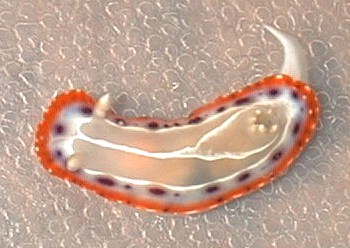
Hello Bill,
Here's a pic of Chromodoris decora from the Line Islands. It's one of the few slugs that didn't come from the Eel Pit dive site.
Data: 20 May 2003, 1300 local time (tide low +1 hour), SW side of Hook Point, London, Christmas Island, Line Islands, Kiribati; under slab with another C. decora on reddish-orange sponge, 1.5m deep; size 15mm
Cheers,
Don
barclay@txucom.net
Barclay, D., 2003 (Jun 27) Chromodoris decora from Christmas I., E. Kiribati. [Message in] Sea Slug Forum. Australian Museum, Sydney. Available from http://www.seaslugforum.net/find/10093Thanks Don,
Its nice to get a few opisthobranch records from Eastern Kiribati. It's not what you would call a regular collecting spot for opisthobranchologists
Cheers,
Bill Rudman
Chromodoris decora from Indonesia
February 22, 2003
From: Danny Van Belle
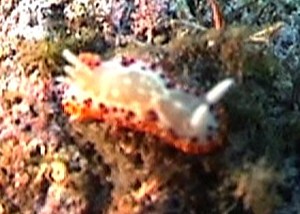
Yes, me again
Here's again one from Bali - Tulamben.
Depth: 5m
Divesite: Paradise Palm Beach, home reef.
Any idea which one this is ?
Danny
dannyvb@hotmail.com
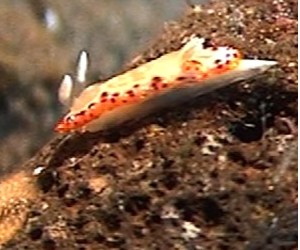
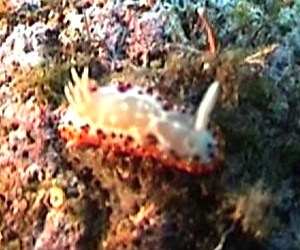
Dear Danny,
Although it does not have the characteristic Y-shaped white mark on the back I am sure this is Chromdoris decora.
Best wishes,
Bill Rudman
Chromodoris decora from Lord Howe Island
January 16, 2003
From: W.B. Rudman
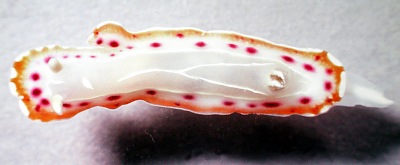
Here is a photo record from Ian Hutton of Chromodoris decora from Lord Howe Island. The photo seems a bit overexposed but the Y-shaped white line is characteristic.
Bill Rudman
Rudman, W.B., 2003 (Jan 16) Chromodoris decora from Lord Howe Island. [Message in] Sea Slug Forum. Australian Museum, Sydney. Available from http://www.seaslugforum.net/find/8827Chromodoris decora from Christmas Island
May 7, 2002
From: W.B. Rudman

Here is a photo of Chromodoris decora from John Hicks' Christmas Island, Indian Ocean collections.
PHOTO: AM C129198, off Cantilever, 24 March 1981, 8-10m depth. Christmas Is., Indian Ocean. Photo: John Hicks
Best wishes,
Bill Rudman
Chromodoris decora from Papua New Guinea
October 7, 2001
From: Marli Wakeling
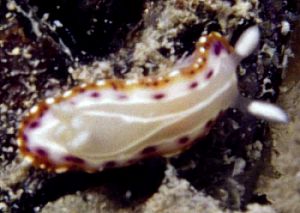
Dear Bill,
I found this Chromodoris on the same site as my many other messages in Kavieng Harbour, Papua New Guinea. It has similarities to other species, but the 'Y' shape on the dorsal area seems unusual. Can you help me identify it, please?
Location: The Old Slipway, Kavieng, Papua New Guinea
Depth: 5 metres
Length: 7mm
Photograph: Marli Wakeling
Thanks,
Marli
scubamarli@excite.com
Wakeling, M., 2001 (Oct 7) Chromodoris decora from Papua New Guinea. [Message in] Sea Slug Forum. Australian Museum, Sydney. Available from http://www.seaslugforum.net/find/5366Dear Marli,
This is Chromodoris decora. The Y pattern is a characteristic of the species, although it is not so obvious in some variants
Best wishes,
Bill Rudman
Tonga Records: Chromodoris decora
May 29, 2001
From: Don Barclay
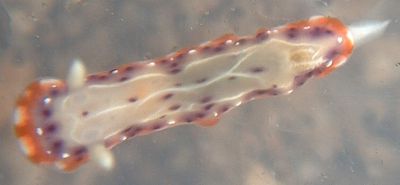
Dear Bill,
Here is a photo of Chromodoris decora I found at Utungake Island, Vava'u, Tonga in February of 2001
Don Barclay
n5ols@samoatelco.com
Barclay, D., 2001 (May 29) Tonga Records: Chromodoris decora. [Message in] Sea Slug Forum. Australian Museum, Sydney. Available from http://www.seaslugforum.net/find/4417Thanks Don,
It's interesting to get these photos of animals with variations on the 'typical' Y-shaped white mark on the dorsum.
Best wishes,
Bill Rudman
Found at at Moloolaba
March 17, 1998
From: Wayne Ellis
Found on the same rock as Noumea simplex (under a rock at the low tide area at Point Cartwright, Moloolaba, southern Qld ) was one Chromodoris decora (10mm), Found a second one (10mm) under another rock next to a pink sponge, (not feeding, resting). Took pics & will send them ASAP.
Regards
Wayne Ellis
glaskin@ozemail.com.au
Ellis, W., 1998 (Mar 17) Found at at Moloolaba. [Message in] Sea Slug Forum. Australian Museum, Sydney. Available from http://www.seaslugforum.net/find/40Another Chromodoris at Moloolaba
March 3, 1998
From: Wayne Ellis
Hi Bill,
The new site looks great. Looking forward to using it. Found four small (10mm) nudis
Location: Point Cartwright, Mooloolaba, southern Queensland. Depth: intertidal.
Description: Fits the description of Chr. decora (Pease,1860) (No 71 in Willan and Coleman's book Nudibranchs of Australasia, 1984). The picture does not do it justice.
Remarks: Two were found together and one alone. All under rocks on a black encrusting sponge (I think). There were signs where the sponge had been eaten where the two were found. A black encrusting sponge is common at this site.
Regards
Wayne Ellis
glaskin@ozemail.com.au
Ellis, W., 1998 (Mar 3) Another Chromodoris at Moloolaba. [Message in] Sea Slug Forum. Australian Museum, Sydney. Available from http://www.seaslugforum.net/find/41Wayne,
Thanks for the information about a possible sponge food of Chromodoris decora. It's a slow job building up information on diets. While some species are always found on their food, others aren't so helpful. We have no good evidence for this species. I have a photo from Nathalie Yonow of Chromodoris decora from the Red Sea crawling alongside a blackish encrusting sponge so you may be on to something. Please keep an an eye out for more 'evidence'... Bill Rudman
